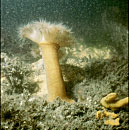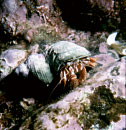4. How do animals adapt to living in this community?
The Intertidal Zone is a very harsh living environment for organisms because its ever changing conditions. Animals in this zone are constantly facing challenges such as varying salinity, drying out by wind and sunlight, predators, strong currents that carry them back to sea, and varying weather conditions. To help with these difficulties many organisms have special adaptation features.
How do organisms protect themselves from drying out?
Some animals, such as sea urchins, carve holes in the rocks and hide in these holes that provide moisture during low tide. Mussels and other shell organisms will tightly close their shell to keep in moisture. Snails secrete a slime that gives them moisture during the long hours of low tide and anemones will fold in their tentacles to hold in moisture. Each of these techniques help the creatures from drying out.

Anemone
(Click for larger image)
How do organisms protect themselves from crashing waves and strong currents?
Many organisms use rocks to help with this problem. Sea Stars and anemones have suction cups, which allow them to latch onto rocks so they are not carried out to sea. Mussels use a thread-like substance called byssal threads that stick to the rocks. Anemones have a unique jelly-like body, which can withstand the crashing waves. For the same reason, sea stars have a strong leathery coating, and many shell organisms such as barnacles have hard shell covering.
How do organisms protect themselves from predators?
As stated previously sea urchins carve holes in rocks and can hide in these holes. Snails can also carve places for protection in rocks. Many other organisms, such as periwinkles and crabs, can hide in cracks and crevices of the rocks for shelter.

Hermit Crab
(Click for larger image)
| 


